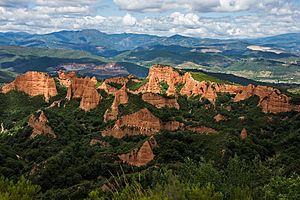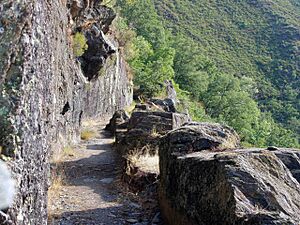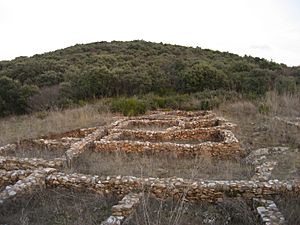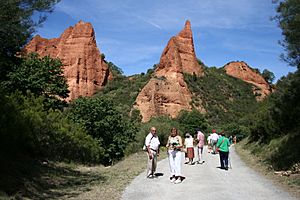Las Médulas facts for kids
| UNESCO World Heritage Site | |
|---|---|
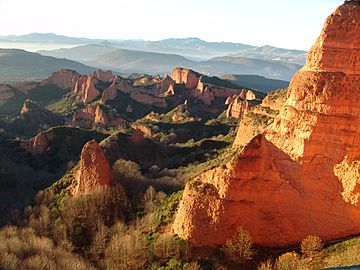
Panoramic view of Las Médulas
|
|
| Location | Province of León, Castile and León, Spain |
| Includes |
|
| Criteria | Cultural: (i), (ii), (iii), (iv) |
| Inscription | 1997 (21st Session) |
| Area | 2,208.2 ha (5,457 acres) |
Las Médulas is a famous historical gold-mining site in Spain. It's located near the town of Ponferrada, in the Province of León, Castile and León. This place was the biggest open-pit gold mine in the entire Roman Empire! Today, Las Médulas is recognized by UNESCO as a World Heritage Site because of its unique landscape and history. In 2014, special aerial surveys using LIDAR technology showed just how huge the Roman mining operations were.
The amazing landscape you see at Las Médulas was created by a Roman mining method called ruina montium, which means "wrecking of the mountains." This technique used large amounts of water to break down mountains and find gold. The water came from far away, through long channels called aqueducts. At least seven of these aqueducts brought water from the La Cabrera mountains, where it rains a lot. These same aqueducts also helped wash the gold out of the soil.
The Romans took over this part of Spain around 25 BC. Before them, local people already found gold in rivers. But the Romans started mining on a much larger scale in the second half of the 1st century AD.
Contents
How Romans Mined Gold at Las Médulas
The Romans were very clever miners! A Roman writer named Pliny the Elder lived in this area around 74 AD. He wrote about the mining methods in his book, Naturalis Historia. He likely saw how they mined gold at Las Médulas.
Pliny described how gold was found in three ways:
- In riverbeds.
- By digging deep shafts (tunnels).
- By "wrecking mountains" (aut in ruina montium quaeritur).
He wrote that the "wrecking of mountains" method was truly incredible. Miners dug long tunnels deep inside the mountains, working by the light of lamps for many months without seeing the sun. These mines were called arrugiae. Sometimes, parts of the tunnels could collapse suddenly, which was very dangerous for the miners.
Water Power: The Key to Gold Mining
After getting the ore, the Romans used smaller streams to wash it. This helped separate the heavy gold particles from the dirt. When the gold near the surface was gone, they dug deeper tunnels to find more gold veins. Many such deep mines have been found around Las Médulas.
Mining usually started by building aqueducts and large water tanks above the areas where they thought gold was. They used a method called "hushing." This involved releasing huge amounts of water from the tanks to wash away the top layers of soil and rock. This exposed the gold veins underneath.
Another method they used was "fire-setting." Miners would build large fires against the rock. Then, they would suddenly pour water on the hot rock. This made the rock crack and weaken. Once the rock was weak, they could break it apart more easily. Then, waves of water would wash away the broken rock and debris. Only when these open-pit methods became too difficult or expensive did they dig long tunnels and shafts to follow the gold veins deep underground.
Pliny the Elder also mentioned that about 6,560 kilograms (or 20,000 Roman pounds) of gold were taken out each year. Over 250 years, with about 60,000 workers, an amazing 1,640,000 kilograms (or 5,000,000 Roman pounds) of gold were extracted from Las Médulas!
Las Médulas: A Special Cultural Landscape
You can still see parts of the ancient Roman aqueducts today, especially in the steep areas. Some even have old Roman writings carved into the rock!
For a long time, most of the research on Las Médulas was done by a person named Claude Domergue. But since 1988, a group of archaeologists from the Spanish Council for Scientific Research (CSIC) started studying the area more deeply. They looked at both pre-Roman and Roman settlements. Because of their work, Las Médulas is now seen as more than just a gold mine. It's a "cultural landscape." This means it shows how Roman mining affected everything: the land, the people, and their way of life.
A World Heritage Site
Thanks to these studies, Las Médulas was named a World Heritage Site by UNESCO in 1997. This is a very important recognition! Since then, a group called the Las Médulas Foundation helps manage and protect this special place. This foundation includes people from local communities, the region, and the country, working together. Today, Las Médulas is a great example of how research, management, and local communities can work together to protect our heritage.
How Mining Changed the Environment
The huge amount of mining at Las Médulas and other Roman sites had a big impact on the environment. Scientists have studied ice cores from Greenland. These ice cores show that air pollution from minerals was highest during the Roman period. The levels of lead in the air during Roman times were not reached again until the Industrial Revolution, about 1,700 years later!
When Las Médulas was being considered for World Heritage status, there was some discussion about this environmental impact. For example, a representative from Thailand wondered if a site created by such large-scale human activity, which changed the environment so much, should be recognized. However, the site was ultimately recognized for its historical and cultural importance, showing how human ingenuity shaped the landscape in the past. It helps us learn about ancient technology and its effects.
Images for kids
See also
 In Spanish: Las Médulas para niños
In Spanish: Las Médulas para niños
- Dolaucothi
- Gold rush
- Roman technology
- Roman aqueducts


